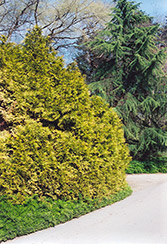Fri & Sat 8am - 8pm
Sun 8am - 7pm
Anytown, USA 12345
fax: 261.787.0463
e-mail: info@successgc.com


Plant Finder

Sunshine Arborvitae
Thuja plicata 'Sunshine'
Height: 40 feet
Spread: 20 feet
Sunlight:
![]()
![]()
Hardiness Zone: 5a
Other Names: Giant Arborvitae, Western Red Cedar
Description:
An aptly-named accent evergreen with rich gold sprays of scale-like leaves that hold their yellow color reasonably well throughout the summer, looks particularly nice against the older darker green sprays; makes a wonderful color accent
Ornamental Features
Sunshine Arborvitae is primarily valued in the landscape for its distinctively pyramidal habit of growth. It has attractive yellow evergreen foliage which emerges gold in spring. The scale-like sprays of foliage are highly ornamental and turn harvest gold in the fall, which persists throughout the winter.
Landscape Attributes
Sunshine Arborvitae is an evergreen tree with a strong central leader and a distinctive and refined pyramidal form. Its relatively fine texture sets it apart from other landscape plants with less refined foliage.
This is a relatively low maintenance tree. When pruning is necessary, it is recommended to only trim back the new growth of the current season, other than to remove any dieback. It has no significant negative characteristics.
Sunshine Arborvitae is recommended for the following landscape applications;
- Accent
- Vertical Accent
- Hedges/Screening
Planting & Growing
Sunshine Arborvitae will grow to be about 40 feet tall at maturity, with a spread of 20 feet. It has a low canopy with a typical clearance of 2 feet from the ground, and should not be planted underneath power lines. It grows at a slow rate, and under ideal conditions can be expected to live for 80 years or more.
This tree does best in full sun to partial shade. It is quite adaptable, prefering to grow in average to wet conditions, and will even tolerate some standing water. It is not particular as to soil type or pH. It is somewhat tolerant of urban pollution, and will benefit from being planted in a relatively sheltered location. Consider applying a thick mulch around the root zone in winter to protect it in exposed locations or colder microclimates. This is a selection of a native North American species.

